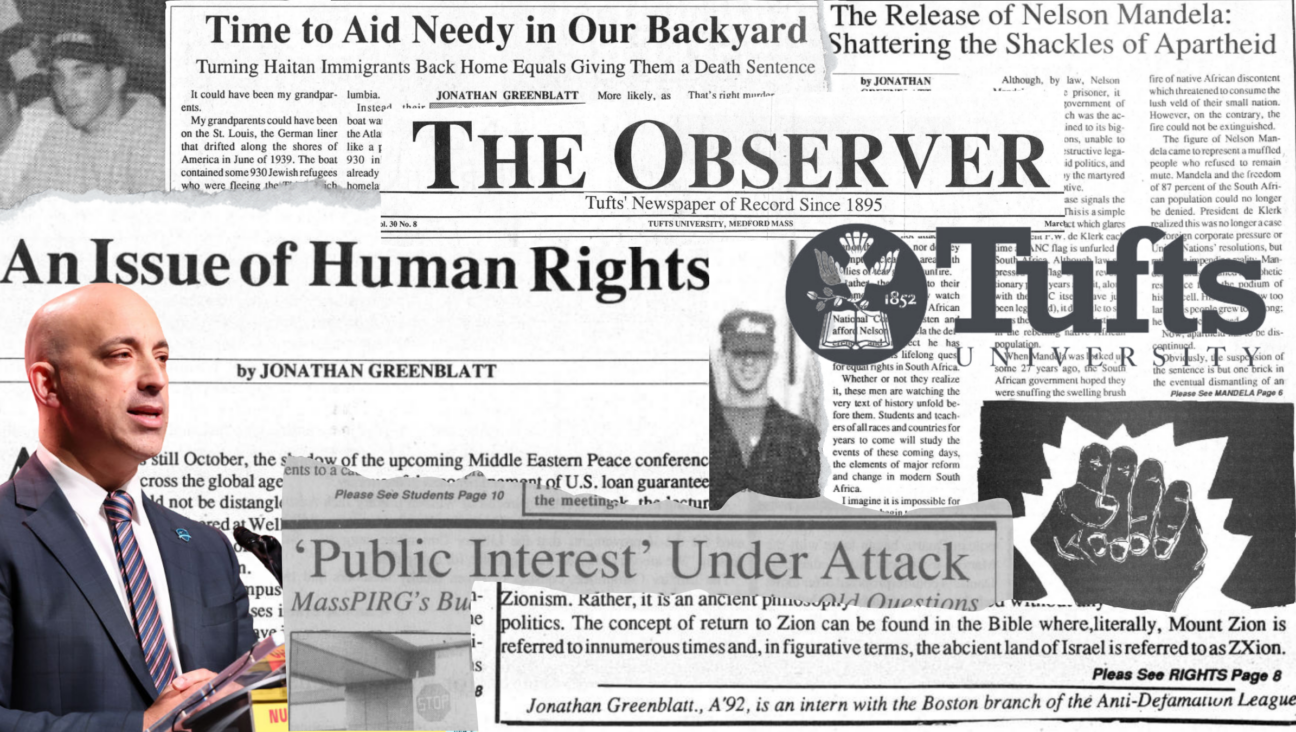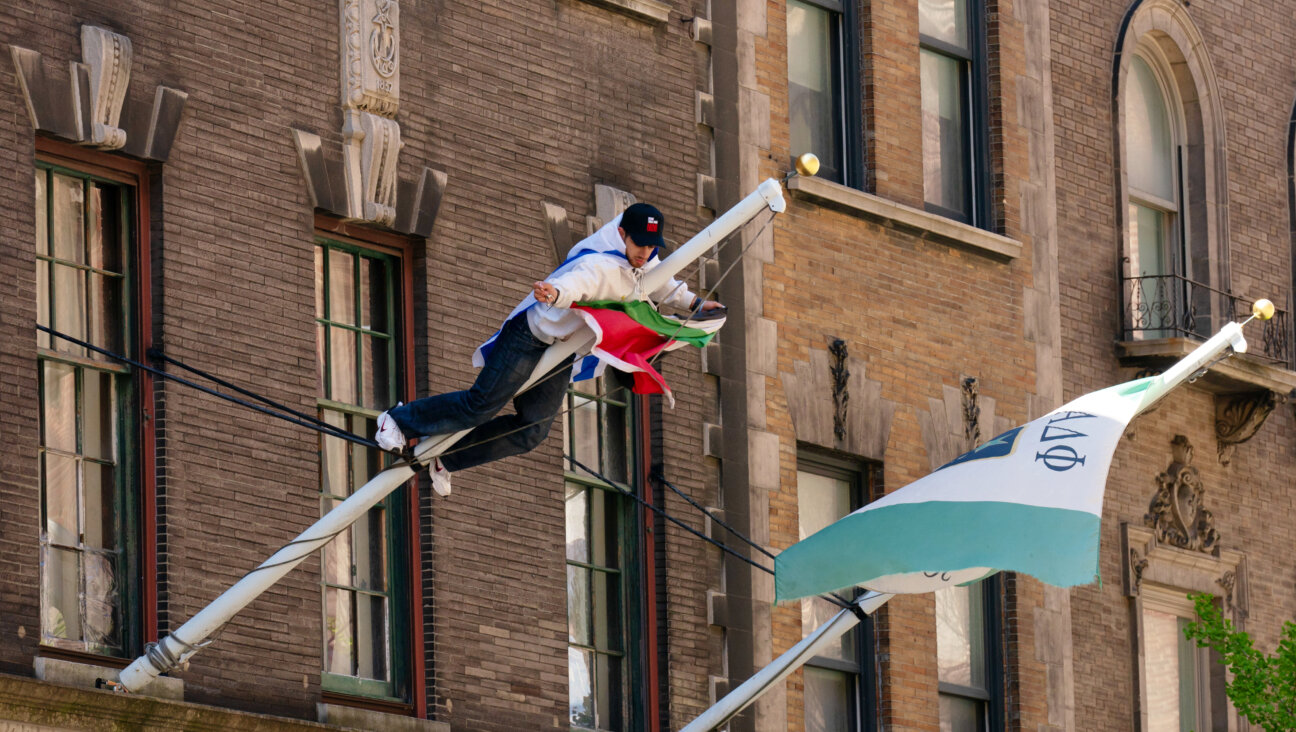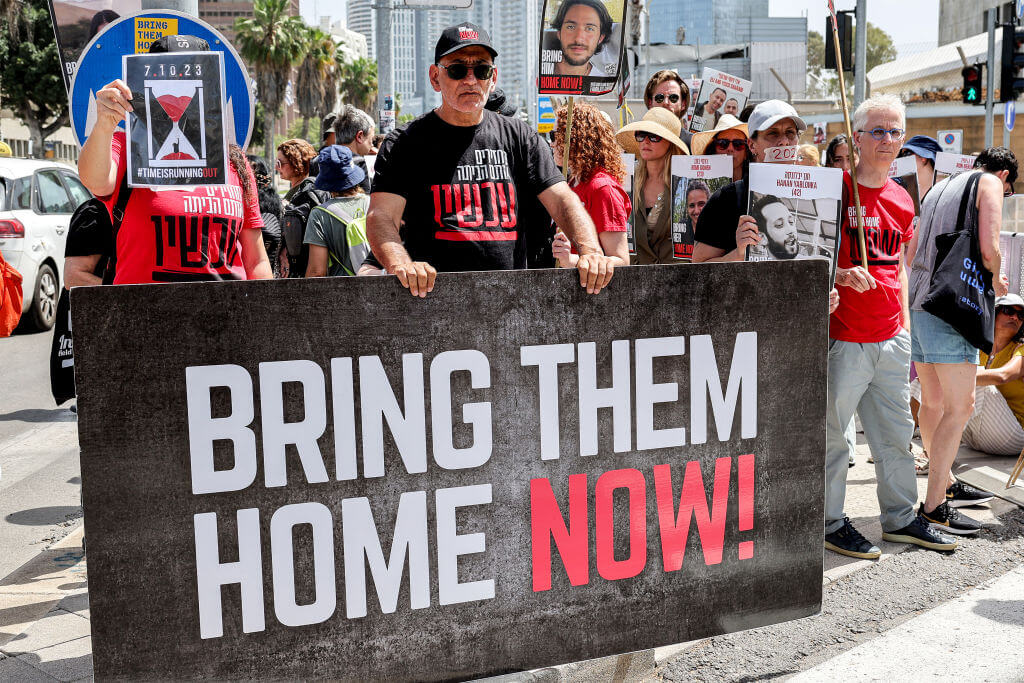Israel’s ravaged kibbutzes have become museums of the macabre. Their former residents want to go home.
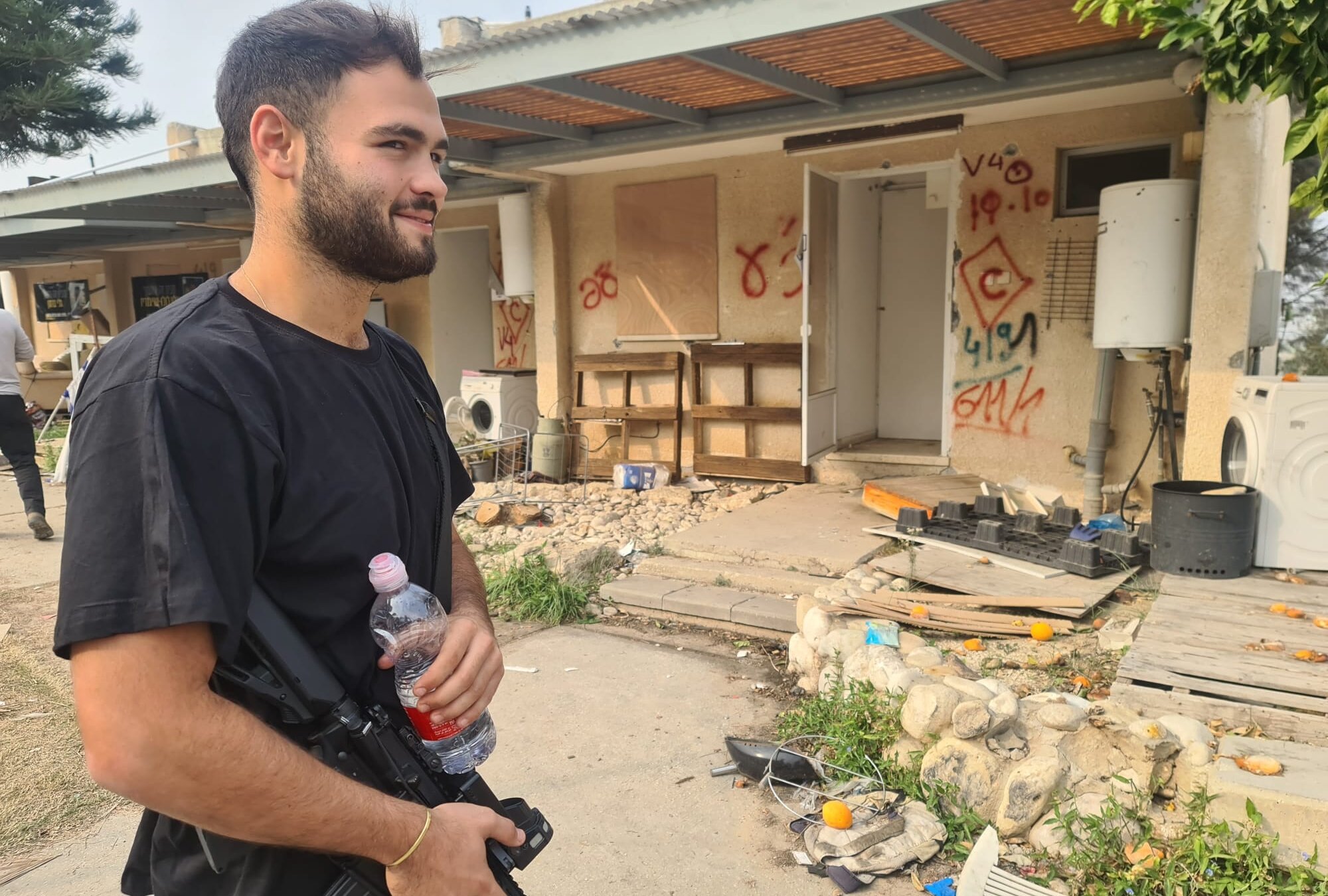
Ido Felus stands outside the wreckage of his home at Kibbutz Kfar Aza, which was devastated by Hamas terrorists on Oct. 7, in January 2024. He believes returning to the kibbutz is essential for Israel’s future. (Deborah Danan)
GAZA ENVELOPE, Israel (JTA) — For Ido Felus, returning to his home in Kfar Aza is not a choice but an imperative that has guided every decision he has made — including what to study in college — since Oct. 7.
“If we don’t come back, the terrorists will have won,” Felus, 24, told the Jewish Telegraphic Agency from outside his home, the corner house in a row of ravaged one-story structures in the devastated kibbutz. Before the attack, he planned to study psychology, but he is now pursuing a business degree, with one ambition only.
“I am making it my life’s mission to rehabilitate this place. It should also be Israel’s most important mission. This area should no longer be peripheral — it should be the center of everything. Israel’s high-tech scene should relocate here,” Felus said.
According to Felus, many of the kibbutz’s younger generation — especially those who are single — feel the same way. “Even those who at first said they can’t come back are now saying they can’t not come back,” he said.
Last week, as the 100-day mark since the attack neared, the first residents of Kfar Aza returned home. Ayelet Cohen and Shachar Shnurman, whose home was one of the few to remain intact during the onslaught, said they were tired of being refugees. Despite the noise of war happening over the border, the middle-aged couple said they were able to sleep much more soundly in the kibbutz.
“In Tel Aviv there is the noise from cars. Here it’s no different than it was in 2014 [during the war with Hamas]. The kibbutz is destroyed, but in terms of the noise, the echoes of the explosions from Gaza is the music we know,” Schnurman told the Israeli news website Ynet. “Some people tell us, good for you, but others say we’ve gone crazy. I can’t disagree with them.”
A month after the war broke out, destruction and rubble dominated the once-arcadian kibbutz. Two months later, the landscape remains starkly unchanged. A notable difference, however, is the volume of visitors, which has risen dramatically, turning the area into a museum of the macabre.

Celebrities and influencers including Jerry Seinfeld, Debra Messing, Montana Tucker, Scooter Braun, Michael Rapaport, Caroline D’Amore, Gregg Sulkin and Emily Austin have all headed to Israel to meet with hostage families and visit the sites of the Oct. 7 massacres. (Screenshots via Instagram, design by Jackie Hajdenberg)
For months, the visitors included volunteers with Zaka, the nonprofit that searching for and evacuating bodies and body parts as well as cleaning out burned vehicles, all according to the dictates of Jewish law. But after almost three months of daily work, Zaka said it has now finished its activities in the Gaza envelope, its spokesman, Moti Bukchin told JTA. Now, the organization is only being called to work in very specific cases, for example, if new rains reveal previously undiscovered body parts or blood.
Still, in every direction, groups of people can be seen milling around, wandering shell-shocked through the debris or listening to their guides — often former residents of the Kibbutz like Felus — recount the horrors they experienced on Oct. 7. Many of them are part of a growing cadre of solidarity mission participants from Jewish communities in the United States, sometimes including celebrities and social media influencers; the area remains a closed military zone, off-limits to civilian Israelis and under ongoing rocket fire from Gaza.
Samuel Hayek, the chairman of JNF-UK, was part of a tour of the decimated kibbutz led by Felus.
“There is only one word to describe what seeing this in real life is like: Devastating,” he said. “We will be there, as we have for years, to strengthen the periphery until their lives and their neighborhoods are restored.”
JNF-UK executive director Yonatan Galon told JTA that for the past decade, the organization has spent roughly $5 to $8 million annually on infrastructure, education, and welfare initiatives across southern Israeli communities. The group’s contributions span a wide range, including the development of leadership programs, parks, promenades, student villages and senior citizen centers in several Gaza border communities such as Nahal Oz, Kerem Shalom, Sderot and Nir Oz.
Six and a half miles away in Beeri, the largest and wealthiest of the Gaza border kibbutzim and in many ways the most brutally assaulted, the destruction immediately appears to be even more extreme in its scope than at Kfar Aza. With half of the houses destroyed beyond repair, the estimated cost of restoring Beeri is just under $80 million, according to estimates by the Tkuma, or Revival, Administration, the new body tasked with rehabilitating and developing the Gaza periphery. The government has allocated $4.8 billion to the administration to handle the affected communities’ short-, mid- and long-term needs.
As at Kfar Aza, Beeri is bustling, but not just with people on guided tours. Some young adults have moved in to tend to the kibbutz in their neighbors’ absence. Farmers have returned to plant wheat in the hope that the harvest will be ready by the time the kibbutz is rebuilt. Busloads of employees of Beeri’s famous printing press arrive every day for work from their hotel near the Dead Sea — a daily commute of three-and-a-half hours. According to Uri Jelin, whose grandfather was one of the kibbutz’s founders, their desire to return to work stems more from the need to cope with their pain than from a commitment to sustaining Beeri’s economy.
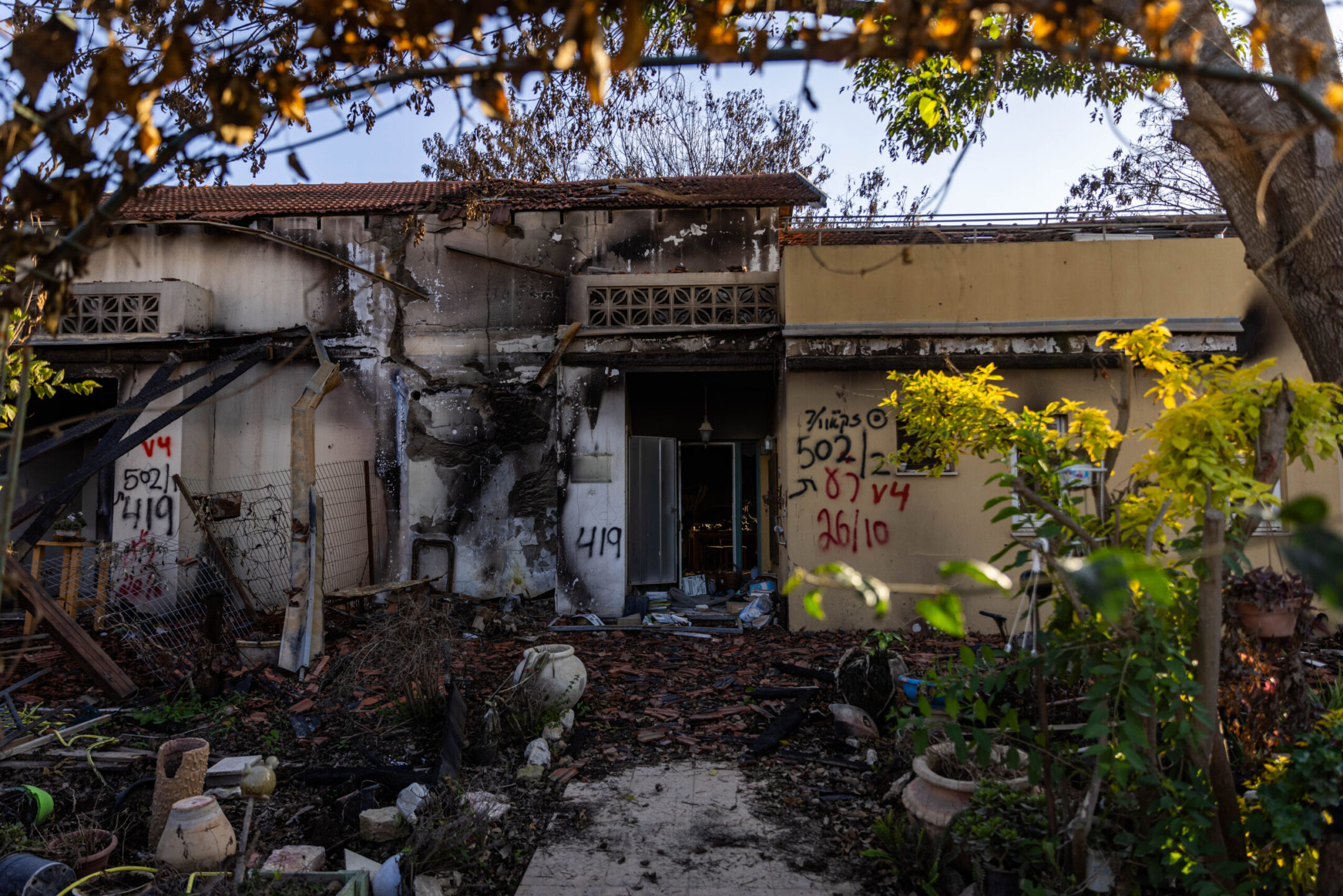
The remains of the destruction caused by Hamas terrorists when they infiltrated Kibbutz Be’eri on October 7, 2023, near the Israeli-Gaza border, southern Israel, as seen on Jan. 4, 2024. (Chaim Goldberg/Flash90)
On Oct. 7, Ben Suchman, the CEO of the press, was on the phone with his mother when a terrorist entered her safe room. He heard the terrorist ask his mother to remove her ring, but it wouldn’t budge. The phone went silent. Days later, authorities handed the ring over to Suchman. His mother was dead.
Jelin pointed to a house that appears to have sustained no apparent damage. “You see this house? It looks innocent, yes? It is anything but. This is where the terrorists enjoyed themselves the most.” Jelin recounts what took place inside the house but asks that the details not be repeated, out of respect for the people who once lived there.
The intact house and close to 200 others like it are becoming a sticking point for plans to rebuild Beeri. Days earlier, officials from the fund for property tax compensation surveyed the houses and determined that many did not meet the criteria for demolition. But residents don’t want to move back into homes that were the sites of extreme violence, even if they are structurally sound.
“How can we talk about coming back when people are refusing to live in houses that their neighbors were murdered in?” said the kibbutz’s secretary, Gili Molcho. The plan, Molcho said, was to establish a request for proposals in the coming weeks for architects to design the village’s reconstruction in a way that helps mitigate the trauma.
Even in exile, the kibbutz makes all decisions as a collective. An offer to move into three new buildings in Jerusalem was turned down. Instead, members of the kibbutz voted to stay in their Dead Sea hotel until new dwellings would be ready in a temporary kibbutz adjacent to Hatzerim, close to Beersheba. Construction was already underway, and the kibbutz anticipated relocating there in six months, with plans to stay for at least an additional two years before returning to Beeri. But as Molcho was quick to point out, “the most certain thing we can say is that there is no certainty.”
An internal survey showed that virtually no Beeri residents — less than 1% — said they never wanted to return to Beeri, Molcho said. Twenty percent said they would return the minute they were given the green light while the rest said it would depend on various factors, the foremost being the security situation. Young families have expressed their refusal to return to an “Oct. 6” Beeri, he said, where “every week or two they launch a couple of missiles from Gaza and we have sirens and go into safe rooms.”
The older generation, along with the sandwich generation beneath them, will return under such conditions, having grown accustomed to them over nearly two decades. Those cohorts were pressing to move back to the areas of Beeri that remain intact as soon as possible, he said. But, he added, “no one got used to living with terrorist infiltrations,” which constituted a clear red line.
“I strongly believe that if there will be quiet over there [in Gaza] Beeri will return and thrive and be bigger and better than before,” Molcho said.
After his tour of Kfar Aza and Beeri, Hayek continued on to Carmei Gat, a new neighborhood in the southern Israeli town of Kiryat Gat, where JNF-UK has donated 13 apartments to residents of Nir Oz who were imminently set to move in. Like Beeri, one of the priorities for Nir Oz, which endured some of the worst of the Hamas attack with a quarter of its community either murdered or kidnapped, was to remain together. Carmei Gat, offering 130 available apartments, was one of the few places that could accommodate this need.
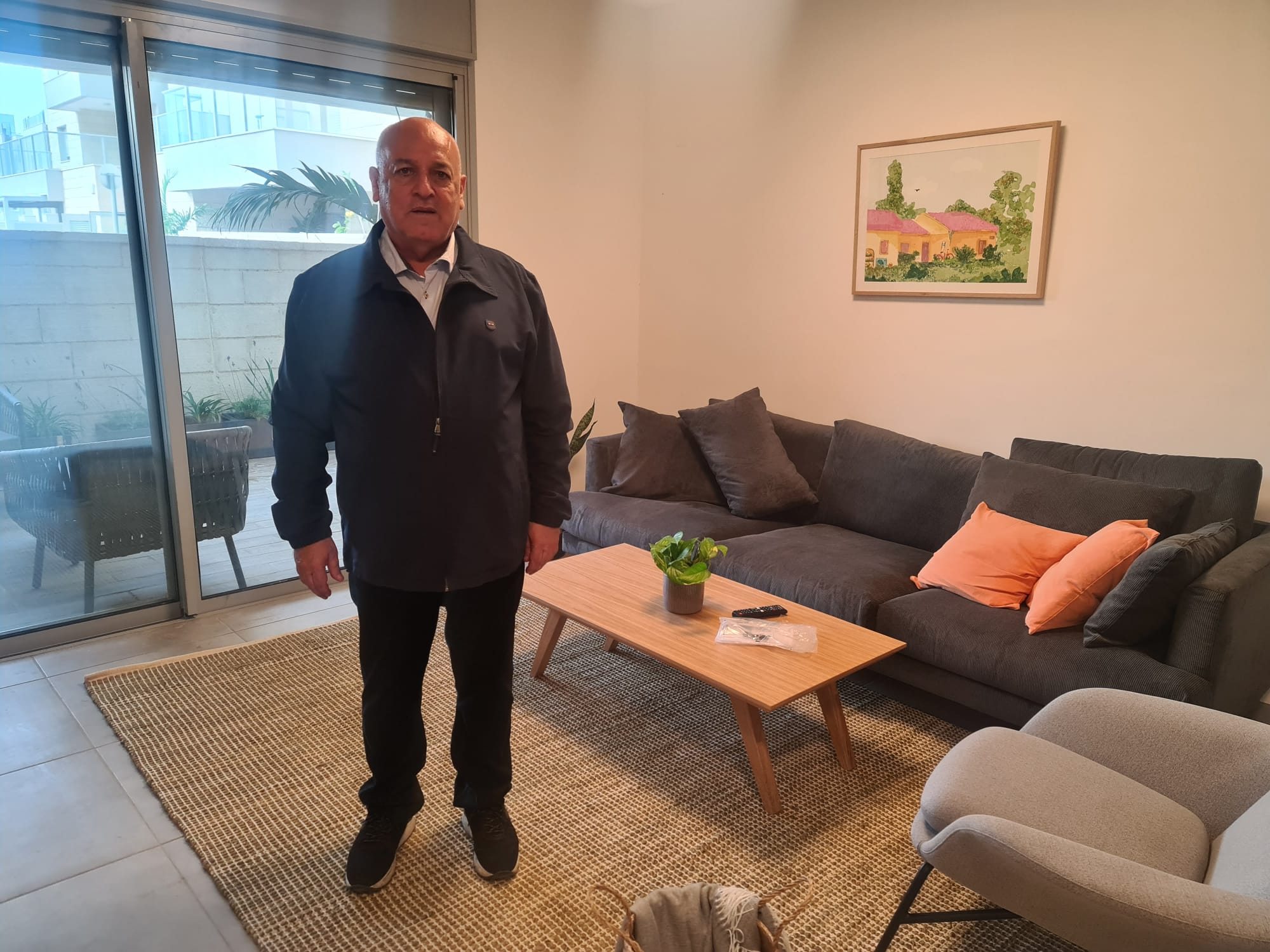
Samuel Hayek, chairman of JNF-UK, stands in an apartment in a new neighborhood, Carmei Gat, that his organization has rented for displaced residents of Kibbutz Nir Oz, January 2024. (Deborah Danan)
“I came to check that the safe rooms lock,” Hayek said, before touring a penthouse apartment. The apartments, initially earmarked for Ukrainian refugees fleeing the war with Russia, were repurposed for the victims of Oct. 7.
“Making this decision was a no-brainer. These people went through a holocaust. We need to do everything to help them,” he said.
The modern apartments had been furnished with thoughtful touches that even extended to milk in the fridge and pictures of bucolic kibbutz scenes, but they still resembled furniture-shop showrooms. They were a far cry from the homey bungalows of Nir Oz, which even in the residents’ absence still brim with character.
Days after Hayek’s visit, the residents of Nir Oz finally left their hotel in Eilat to move into the new apartments. A week after settling into his apartment, Jonathan Dekel-Chen has yet to acclimate to his new surroundings. “It was most definitely time for us to move on to a place where we could properly grieve, to the degree that we can grieve, because this is an ongoing saga,” Dekel-Chen, an American-born professor at the Hebrew University, told JTA.
Dekel-Chen’s son, Sagui, JNF-UK’s national project coordinator, is being held as a hostage in Gaza. Sagui’s wife, who just gave birth to the couple’s third child, is also living in a JNF-UK apartment. Sagui’s mother, Dekel-Chen’s ex-wife, was also injured and taken captive on Oct. 7, but managed to escape at the last moment.
“There are still weeks to go before we all really figure out again, individually and families, how we navigate this very new space with none of our actual property,” Dekel-Chen said.
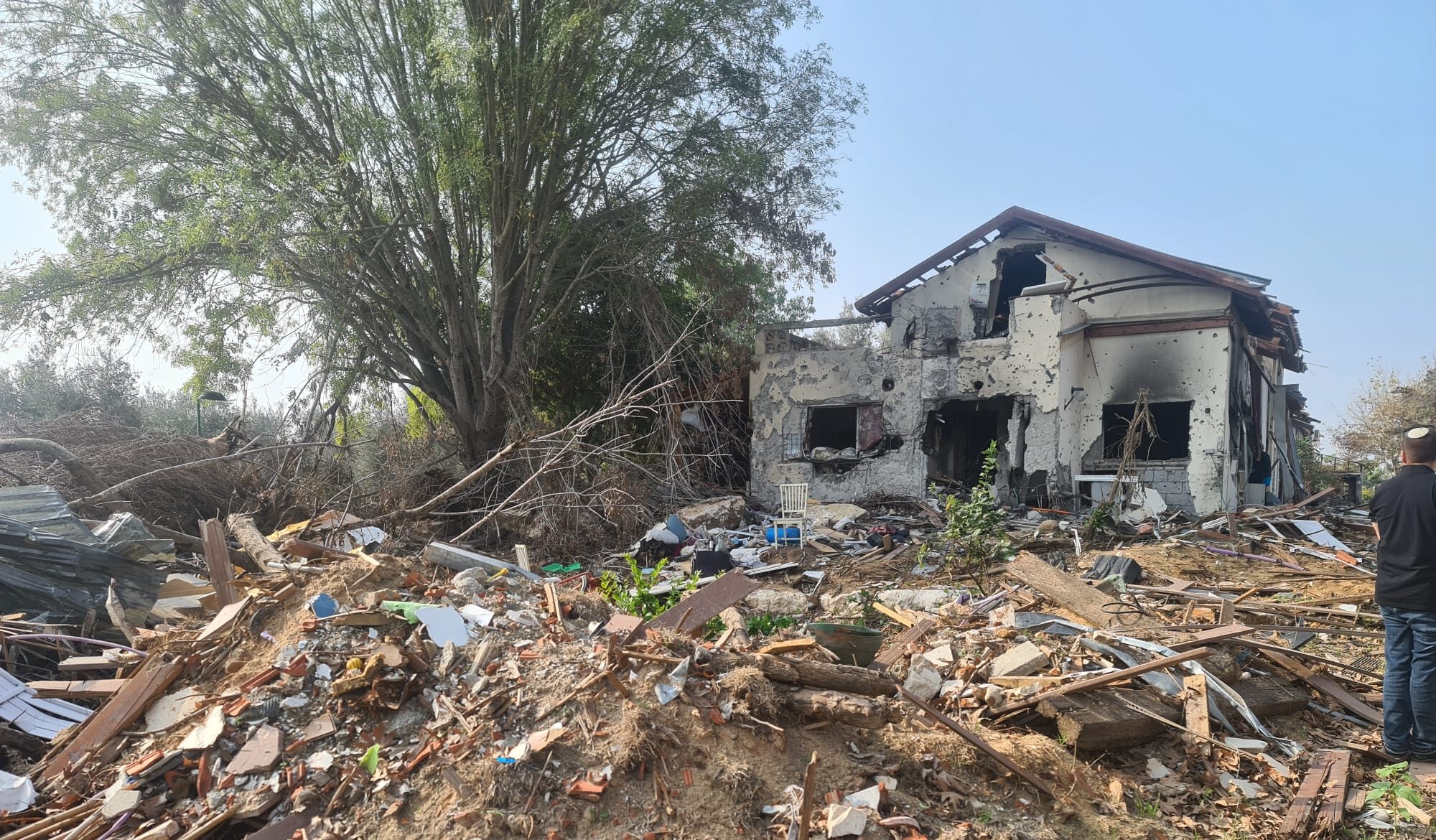
Kibbutz Beeri as seen in January 2024, three months after it was the site of a Hamas massacre. (Deborah Danan)
He described the community’s adjustment to its new environment as an “out-of-body” experience.
“It’s foreign to everything we know. It’s foreign in terms of the landscape, it’s foreign in terms of living, you know, on multiple floors. We are used to living in nature and with the colors of nature, the feel of nature at our doorstep,” he said. “When I look out now, in my home, I’m on the fourth floor of a building, and all I can see are cars, asphalt, concrete and metal.”
Initially, the Nir Oz community had planned to stay in Carmei Gat for less than a year while a new community would be constructed for them, similar to the one being built for Beeri near Hatzerim. They had planned to relocate there for one to two years before contemplating a permanent move. But according to Dekel-Chen, that step was scrapped because none of the residents wanted to live in two temporary homes.
Right now, few members of the kibbutz are able to provide a definitive answer about making a permanent return to Nir Oz in the future. Most of those with younger children told JTA outright that they wouldn’t consider it. But where the community eventually ends up and whether it will be one place or several remains an open question, Dekel-Chen said. A tentative agreement had been drawn up with two or three kibbutzim that could accommodate large groups of Nir Oz members.
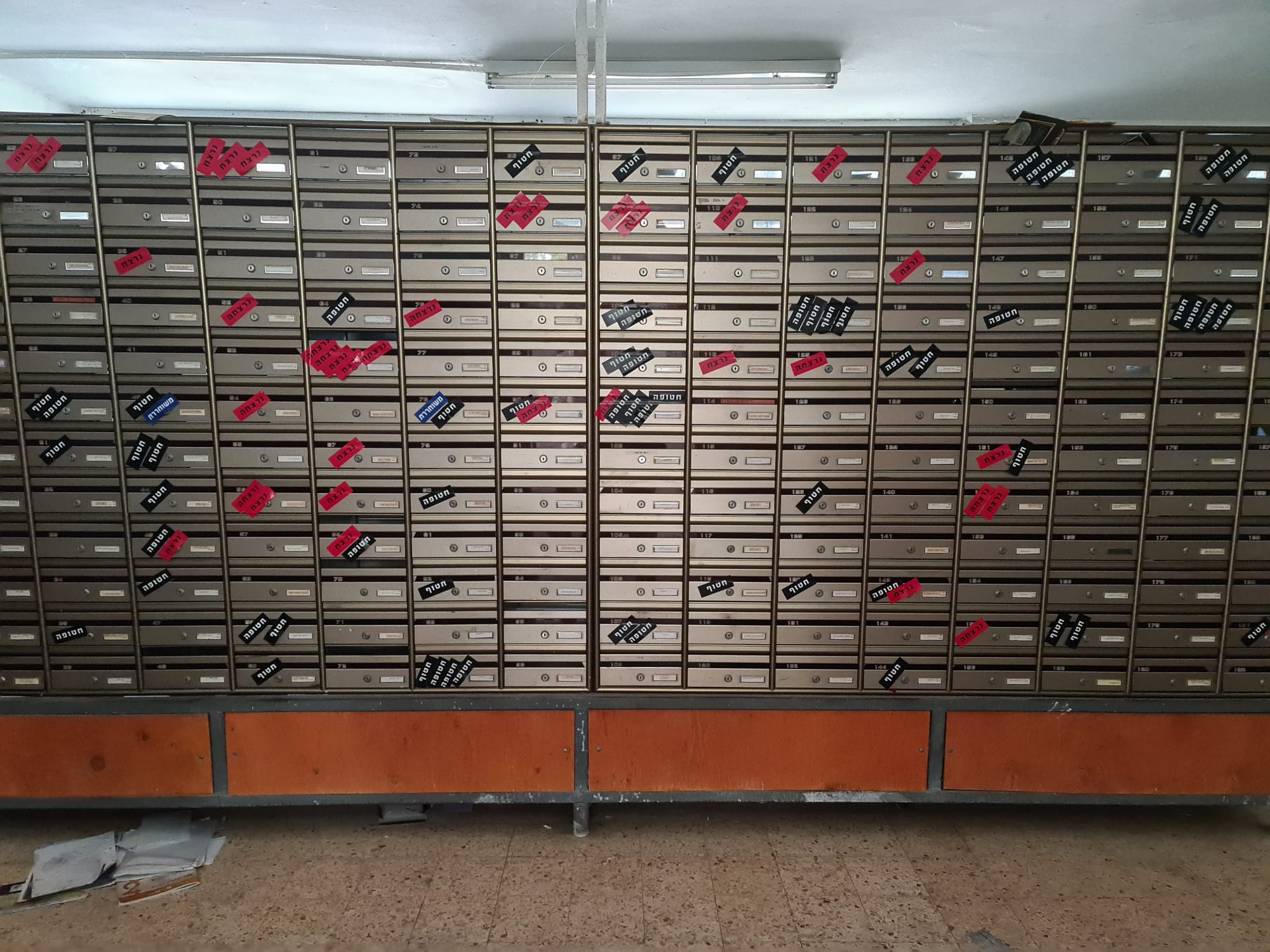
The mailboxes at Kibbutz Nir Oz are marked red for those who were murdered on Oct. 7, black for those taken hostage. (Deborah Danan)
Part of their eventual resettlement would rely on a negotiated deal with the Tkuma Administration, he said. The administration “thought everybody was going back to Nir Oz, but clearly that’s not going to happen. Young families and many of the older folks absolutely have no intention of ever going back there,” he said.
The contours of the administration’s ultimate efforts remain unknown. If the administration fails to support people who refused to move back to their original towns, it would be a “national outrage,” Dekel-Chen said.
For its part, the agency told JTA it would help those who did not wish to return to Nir Oz and likewise, in the meantime, if individuals decided to move out of Carmei Gat, it would continue to assist them with the financial and other aid they are currently receiving, including rent and furnishings. But the administration said it had no plans to build new settlements or expand existing ones for the Nir Oz community and maintained that based on conversations it had with residents, most wanted to eventually return.
Meanwhile, the approach to memorializing the massacres in each village has also become a point of debate, both within each community and outside. Tkuma said it was working with the Ministry of Heritage as well as local representatives from each village to find ways to honor the victims and preserve the memory of Oct. 7. Molcho envisioned transforming a small corner of the kibbutz into a commemoration area, but nothing more.
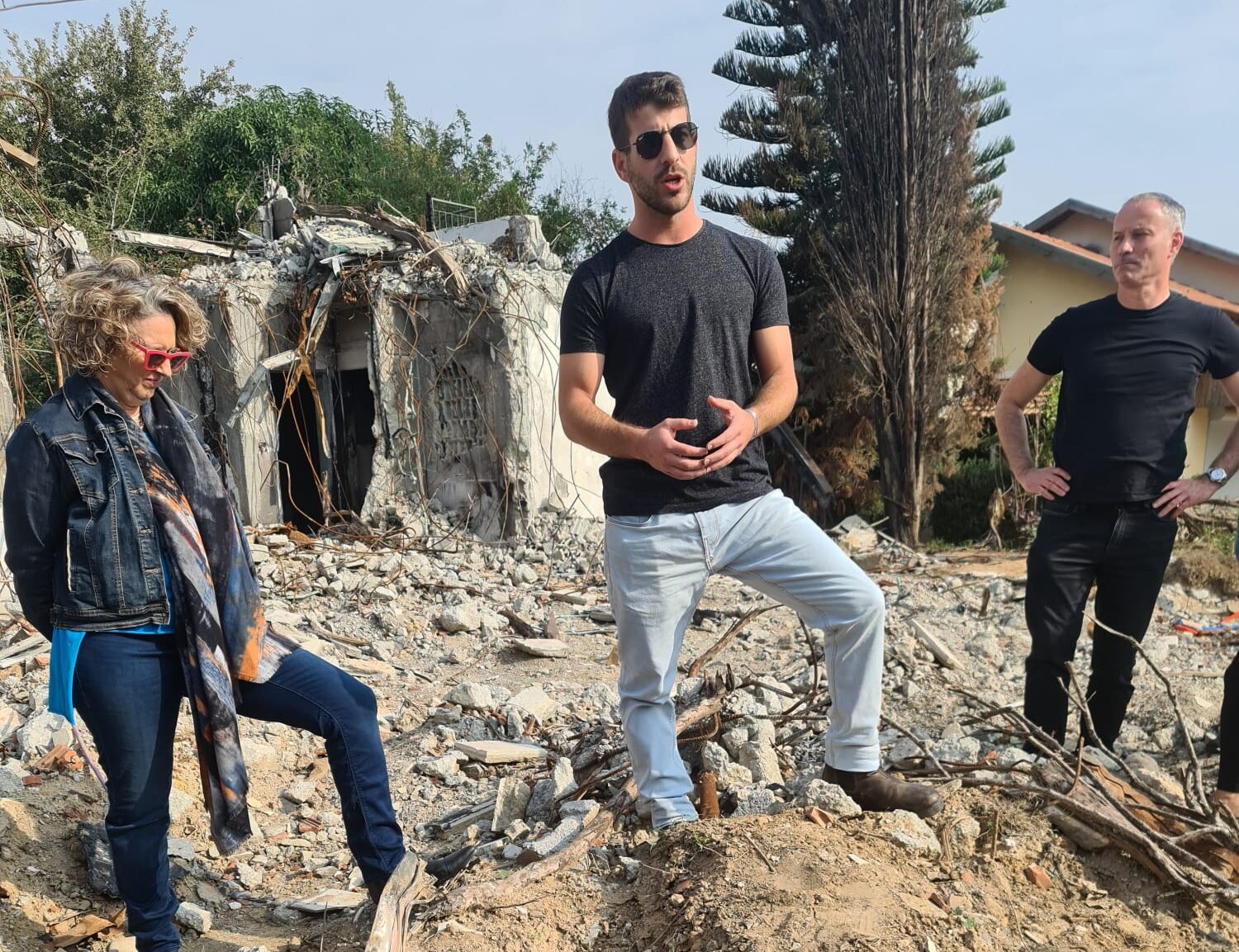
Uri Jelin stands atop wreckage at Kibbutz Beeri, founded by his grandfather, in January 2024. (Deborah Danan)
“Our goal is to restore this place for normal living as much as possible, and not turn it into a memorial site,” he said.
Felus had a different take, believing that the entire 100-yard strip of Kfar Aza known as the “younger generation” zone, where not a single house survived, should be cordoned off and preserved in its current state of ruin as a historical testament for future generations. He said he understood the potential trauma that such a memorial might evoke for some — in part because it’s one he experiences all the time.
“All I do is remember. Every step I take in this kibbutz I think, this friend was murdered here, that one was taken hostage there,” he said. “There’s no getting away from it anyway.”
This article originally appeared on JTA.org.

I hope you appreciated this article. Before you go, I’d like to ask you to please support the Forward’s award-winning journalism this Passover.
In this age of misinformation, our work is needed like never before. We report on the news that matters most to American Jews, driven by truth, not ideology.
At a time when newsrooms are closing or cutting back, the Forward has removed its paywall. That means for the first time in our 126-year history, Forward journalism is free to everyone, everywhere. With an ongoing war, rising antisemitism, and a flood of disinformation that may affect the upcoming election, we believe that free and open access to Jewish journalism is imperative.
Readers like you make it all possible. Right now, we’re in the middle of our Passover Pledge Drive and we still need 300 people to step up and make a gift to sustain our trustworthy, independent journalism.
Make a gift of any size and become a Forward member today. You’ll support our mission to tell the American Jewish story fully and fairly.
— Rachel Fishman Feddersen, Publisher and CEO
Join our mission to tell the Jewish story fully and fairly.
Only 300 more gifts needed by April 30







